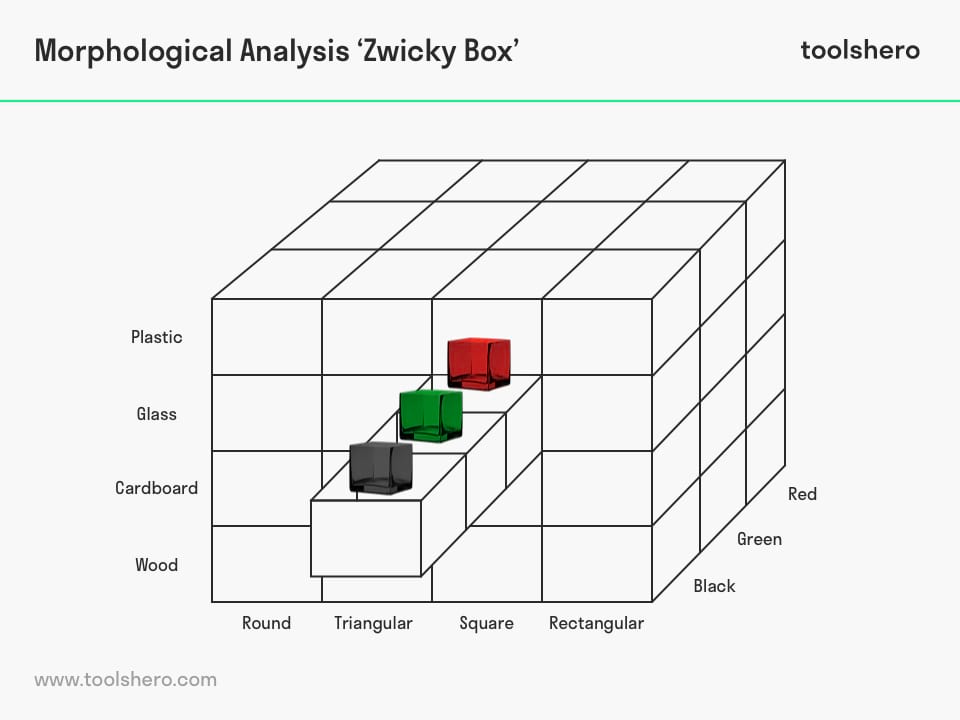Morphological Analysis: the Theory and Definition

Morphological Analysis: this article explains Morphological Analysis by Fritz Zwicky in a practical way. This article contains a general explanation of the Morphological Analysis, its characteristics and an example. After reading you will understand the basics of this creativity and problem solving tool. Enjoy reading!
What is Morphological Analysis? The theory and definition
Morphological Analysis (MA) can also be referred to as ‘problem solving’. It is visually recorded in a morphological overview, often called a ‘Morphological Chart’. The method was developed in the 1960s by Fritz Zwicky, an astronomer from Switzerland. This analysis is about exploring all possible solutions to a complex problem. It is used when exploring new and different ideas.
Morphological Analysis can be defined as an analysis that provides a structured inventory of possible solutions.
It is a question of splitting the problem into partial problems and looking at possible options for each part of the problem. In this way, all aspects of a problem are thoroughly investigated. This makes Morphological Analysis a relatively simple technique that produces good, useful results.
Characteristics of a Morphological Analysis
With Morphological Analysis, different solutions to a complex problem can already be found in the design phase. Fritz Zwicky applied Morphological Analysis to astronomical research and development of jet engines and missiles. A complex problem has the following characteristics:
1. Multidimensional
Each problem has multiple angles that need to be treated as a whole.
2. Quantifiable
The various aspects of a problem are quantifiable and expressed in numbers. They are also constantly changing, which must be included in the search for possible solutions.
3. Subjective
The right solution to the problem is a matter of opinion. The best solution does not exist, but there are better or worse solutions.
How to do a Morphological Analysis: the steps
When using Morphological Analysis, there is a Morphological Chart. The following process steps are necessary to get a useful model:
1. Problem Description
The problem is defined in a short and clear description; what it is, what it’s not and what it should be. A problem definition can now be formulated. Suppose a manufacturer of luxury wine glasses is looking for a beautiful gift box. Based on a number of conditions (safety, sturdiness etc.) the manufacturer indicates what the packaging should include.
2. Identify dimensions
This phase determines what is important for solving a problem. The problem is divided into different dimensions. These perspectives provide potential parameters that can solve the problem. The first dimension in the above example is the shape of the package, the second dimension is the colour of the package and the third dimension is the chosen materials. Multiple dimensions can also be chosen.
3. Properties
By looking for as many features as possible for the different dimensions, many options for solutions are created. Creativity is offered here. For example, the shape may be round, triangular, square or rectangular.
The colour may be black, green or red and the choice of materials may be wood, cardboard, glass or plastic. The more properties are included, the more options there are.
4. Combining
By making arbitrary combinations, there are many solutions that may be applied. From this, a Morphological Chart or Morphological Overview can be made, which is visualised as a matrix.
For each dimension, all possible conditions are summarised and it is possible to look at what new ideas this creates.
5. Evaluation
Finally, the possible solutions should be evaluated. Which solution is feasible and consistent and which will absolutely not be used? If a solution is not consistent or is unusable, then a cross will appear in the appropriate field of the matrix. That solution is excluded.
6. Implementation
The desired solution identified in the morphological overview can be chosen and implemented.
Morphological Analysis chart components
Morphological Analysis has several concepts that were discussed in the above steps. First, there is the Morphological Chart; this is the visual matrix containing so-called morphological cells.
In the columns (top to bottom), the dimensions are set and the rows (left to right) list the conditions that a dimension could meet. The combination of columns and rows creates the cells. In each cell, the value of the condition is mentioned.
The dimensions themselves indicate the viewpoints or characteristics that are related to the problem definition. The condition is the state of a dimension and the value is the relevance condition of a dimension.
In the Morphological Chart, you can see by looking at the crosses which solution is not possible. The list shows what the current choice and what the proposed choice is by connecting choices with lines.
Morphological Analysis: Input and output
The quality of the delivered solutions (input) is also a measure of the quality of the output (output). When the quality of the basic information is high, it is likely that the result will also be of high quality.
In the example given above, we are dealing with the following three dimensions: shape (round, triangular, square or rectangular), colour (black, green or red) and material (wood, cardboard, glass or plastic). With these data there are 4 x 3 x 4 = 48 possibilities shown in the morphological overview with a total of 48 cells.
The three dimensions will change the matrix into a three-dimensional cube. Each cell provides an option. If there are many variables included in the Morphological Chart, that results in a great deal of complexity. In order to overcome this, it is desirable to use computer support, which makes it easier to arrive at a good and useful result.

Figure 1 – The Morphological Analysis Zwicky Box
In addition, creativity is most welcome as application to Morphological Analysis. The more creative ideas, the more combinations of choices there are.
There are many creative thinking techniques that can be applied to Morphological Analysis, including Six Thinking Hats by Edward de Bono, mind mapping and Brainstorming.
It’s Your Turn
What do you think? Can you apply Morphological Analysis in today’s modern business companies? Do you recognize the practical explanation or do you have more suggestions? What are your success factors for problem analysis and problem solving?
Share your experience and knowledge in the comments box below.
More information
- Ritchey, T. (2011). General Morphological Analysis (GMA). In Wicked problems–Social messes (pp. 7-18). Springer Berlin Heidelberg.
- Fritz Zwicky. (1969). Discovery, Invention, Research – Through the Morphological Approach. Toronto: The Macmillan Company.
- Zwicky, F. & Wilson A. (eds.) (1967). New Methods of Thought and Procedure: Contributions to the Symposium on Methodologies. Berlin: Springer.
How to cite this article:
Mulder, P. (2017). Morphological Analysis (Zwicky). Retrieved [insert date] from Toolshero: https://www.toolshero.com/creativity/morphological-analysis-fritz-zwicky/
Original publication date: 12/12/2017 | Last update: 03/25/2024
Add a link to this page on your website:
<a href=”https://www.toolshero.com/creativity/morphological-analysis-fritz-zwicky/”>Toolshero: Morphological Analysis (Zwicky)</a>













2 responses to “Morphological Analysis: the Theory and Definition”
Very helpful tips. Am using morphological analysis in computational Natural language
Thank you for your feedback and sharing your experience Chio. I am glad that you found the article helpful.